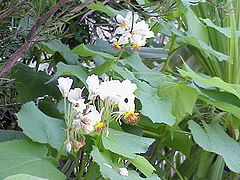Sparmannia
| Sparmannia subsp. var. | African hemp, House lime | |||||||||||||||||||||||||||||||||||||||||||||||||||||||
|---|---|---|---|---|---|---|---|---|---|---|---|---|---|---|---|---|---|---|---|---|---|---|---|---|---|---|---|---|---|---|---|---|---|---|---|---|---|---|---|---|---|---|---|---|---|---|---|---|---|---|---|---|---|---|---|---|

|
|
| ||||||||||||||||||||||||||||||||||||||||||||||||||||||
| ||||||||||||||||||||||||||||||||||||||||||||||||||||||||
Describe genus here...
| Standard Cyclopedia of Horticulture |
|---|
|
Sparmannia (named for Andreas Sparmann, 1747-1787). Tiliaceae. Shrubs or trees, with soft stellate pubescence, grown in the greenhouse and also out-of-doors in the southern United States. Leaves cordate, dentate, or lobed: fls. white, in terminal, umbelliform little cymes; sepals 4, petals 4, naked at the base; stamens numerous, free; ovary nearly 4-celled: caps. globose, spiny.—About 5 species, Afr. Sparmannia africana is of easy treatment under glass in a moderate temperature with plenty of air and light. The plants are benefited by being plunged in the garden in the summer and syringed during dry weather. Plants should be potted early in spring. The tips of young shoots root readily with 60° of heat. CH
|
Cultivation
Propagation
Pests and diseases
Species
Gallery
-
photo 1
-
photo 2
-
photo 3
References
External links
- w:Sparmannia. Some of the material on this page may be from Wikipedia, under the Creative Commons license.
- Sparmannia QR Code (Size 50, 100, 200, 500)
